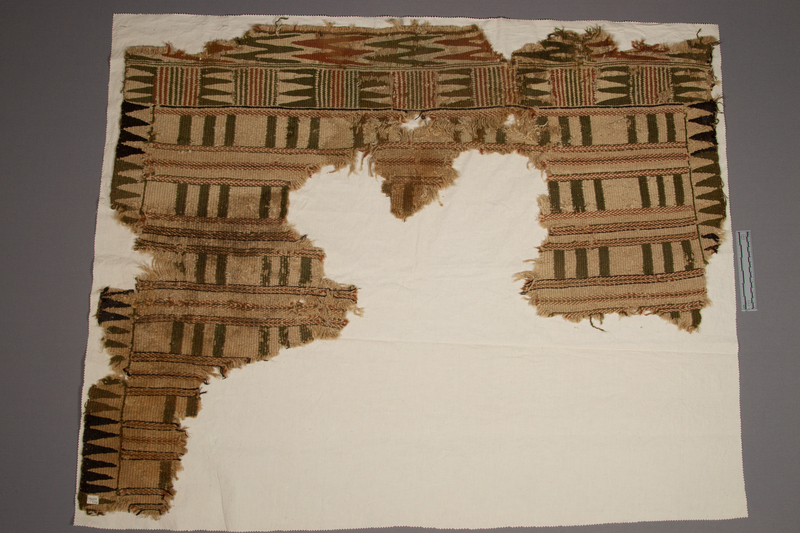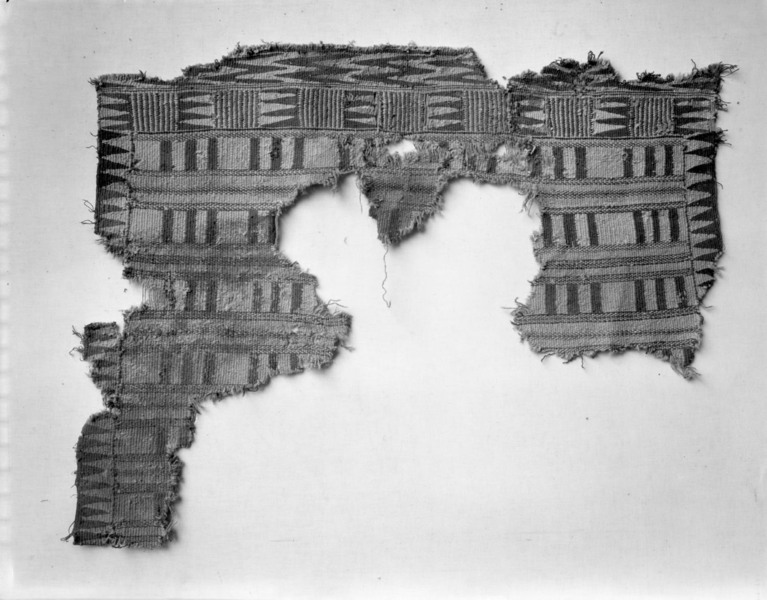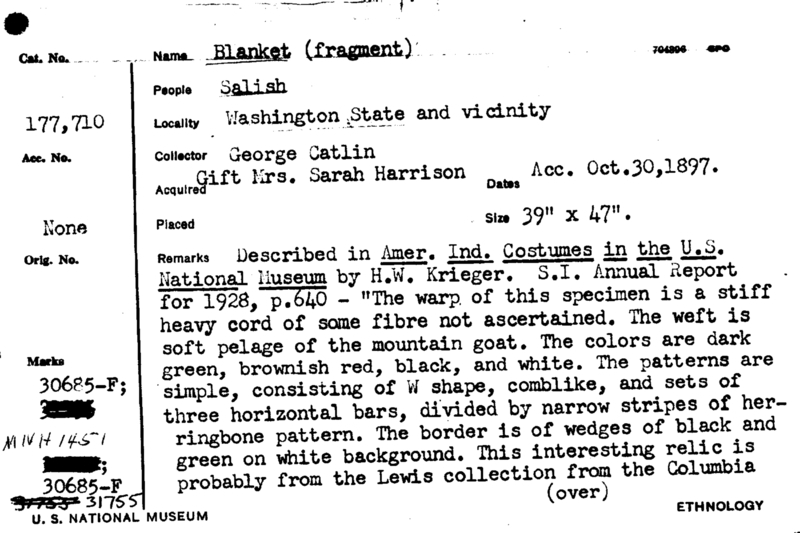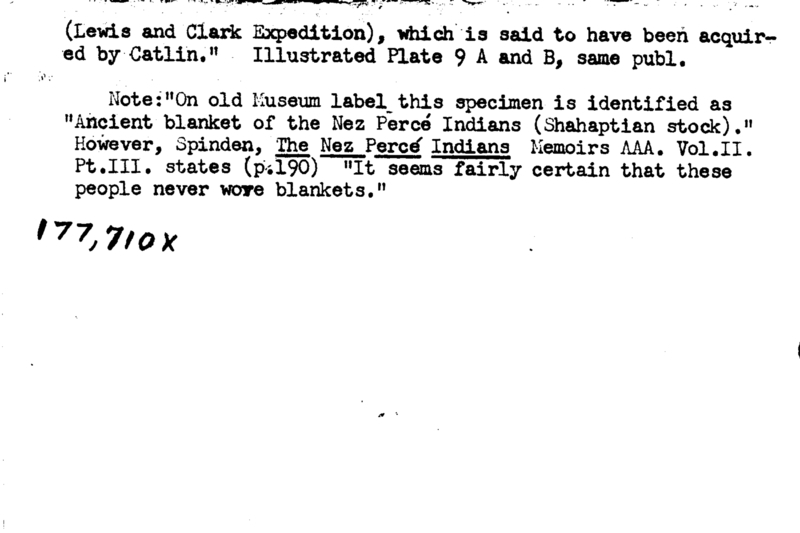Blanket (Fragment) Item Number: E177710-0 from the National Museum of Natural History








Notes
From card: "Described in Amer. Ind. Costumes in the U.S. National Museum by H.W. Krieger. S.I. Annual Report for 1928, p. 640: "The warp of this specimen is a stiff heavy cord of some fibre not ascertained. The weft is soft pelage of the mountain goat. The colors are dark green, brownish red, black, and white. The patterns are simple, consisting of w shape, comblike, and sets of three horizontal bars, divided by narrow stripes of herringbone pattern. The border is of wedges of black and green on white background. This interesting relic is probably [?] from the Lewis Collection from the Columbia (Lewis and Clark Expedition), which is said to have been acquired by Catlin." Illustrated plate 9 a and b, same publ. Note: "on old museum label this specimen is identified as "ancient blanket of the Nez Perce Indians (Shahaptian stock) [sic]." However, Spinden, in the "Nez Perce Indians" Memoirs AAA. Vol.II Pt.III. states (p.190) "It seems fairly certain that these people never wove blankets."From 19th or early 20th century exhibit label with card: "177,710A. Ancient blanket of the Salish Indians .... The warp is of two-ply twine of Indian hemp. The weft is of dog hair. The warp is not set on a loom, but is suspended from a pole, and the weft is inserted by twine weaving in precisely the same manner as the basketry of the Tlingit Indians and tribes farther south, only the blanket is woven from the top downward."Fragment of Classic Salish blanket, illus. Fig. 29, p. 46, in Salish Weaving by Paula Gustafson, University of Washington Press, 1980. It is described on p. 125, cat. entry 84: "Colour: Dark green, brownish-red, black and white, all faded. Weave: Twine." It is also described on p. 47-8 of Gustafson as: "... both the warp and weft are of vegetable fibre, probably Indian hemp. The blanket appears to have been designed with at least fourteen horizontal bars, six or more of which are broken by dark vertical lines. It is bordered on at least two sides by an arrowhead pattern, and the one remaining edge carries two horizontal panels, one repeating the arrowhead design of the borders but with narrow vertical red and blue stripes, and the lower edge evidencing a red and black zigzag pattern. The original fibre colour has aged to a soft honey yellow and the dyed areas have faded slightly, giving a mellow appearance to the finely woven fragment."There has been speculation (see reference above) that some of the Northwest Coast artifacts in the Catlin collection came originally either from the Lewis and Clark Expedition of 1804-1806 or from Clark's Indian Museum in St. Louis (1816-1838). Catlin did know Clark, however there is no proof or documentation that Lewis and Clark Expedition artifacts or Clark artifacts are in the Catlin collections. See "William Clark's Indian Museum in St. Louis 1816-1838" by John C. Ewers, in "A Cabinet of Curiosities", ed. Walter Whitehill, University of Virginia Press, 1967.Reference: Solazzo, C., S. Heald, M.W. Ballard, D.A. Ashford, P.T. DePriest, R.J. Koestler, and M. Collins. 2011. Proteomics and Coast Salish blankets: A tale of shaggy dogs? Antiquity 85: 1418-1432. http://antiquity.ac.uk/ant/085/ant0851418.htm . Identified there as a Classic (1778 - 1850) blanket - mixture of Mountain goat hair and Salish wool or woolly dog hair in both warp and weft.See p. 296 in Catlin, George. 1848. Catlin's notes of eight years' travels and residence in Europe with his North American Indian collection: with anecdotes and incidents of the travels and adventures of three different parties of American Indians whom he introduced to the courts of England, France, and Belgium, Vol. 1. New-York: Burgess, Stringer & Co. There Catlin is describing his "Indian Gallery" artifacts, and notes that they include "Indian Cloths, Robes &c, manufactured by the Indians from the mountain sheep's wool, and from wild [sic] dogs' hair, beautifully spun, coloured, and woven." See p. 386 in "The George Catlin Indian Gallery in the U.S. National Museum (Smithsonian Institution) with Memoir and Statistics" by Thomas [Corwin] Donaldson, in Annual Report of the Smithsonian Institution for 1885, part 5, Government Printing Office, 1886, https://www.biodiversitylibrary.org/page/31077461 . It is noted there: "After Mr. Catlin's return to London from Paris in 1848, he added to his gallery a series of full-length costumed figures [mannequins]." See also p. 388 of the same publication https://www.biodiversitylibrary.org/page/31077463 . There it is noted that one of these mannequins, Catlin display mannequin # 625, depicted "A Nay-as Woman, wearing ... a splendid robe, made of the wool of the mountain sheep and wild [sic] dog's hair ... ."Illus. Fig. 40, p. 99 (detail), in Tepper, Leslie Heymann, Janice George, and Willard Joseph. 2017. Salish Blankets: robes of protection and transformation, symbols of wealth.
Item History
- Made in Washington, USA ? or Oregon, USA ?
- Collected by George Catlin and Lewis & Clark Expedition in Washington, USA ? or Oregon, USA ?
- Received from Thomas Donaldson on October 21, 1881
What
- Name
- Blanket (Fragment)
- Identification Number
- E177710-0
- Type of Item
- blanket
Who
- Culture
- Salish
- Field Collector
- George Catlin and Lewis & Clark Expedition
- Received from
- Thomas Donaldson
Where
- Holding Institution
- National Museum of Natural History
- Made in
- Washington, USA ? or Oregon, USA ?
- Collected in
- Washington, USA ? or Oregon, USA ?
When
- Acquisition Date
- on October 21, 1881
Other
- Accession Number
- 010638